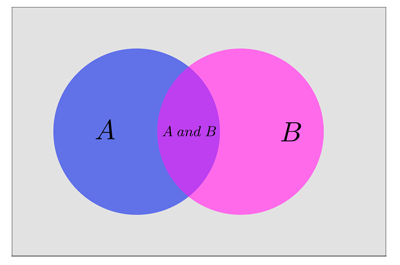Suppose I roll a die and ask you to guess the number I roll. What's the chance of you getting it right?
As long as the die is fair, so all numbers are equally likely to be rolled, the probability of you guessing correctly is 1/6. But what if I tell you, before I uncover the result, that the number I have rolled is odd? Then there are only three possible outcomes: 1, 3, and 5. The chance of you guessing correctly is now 1/3. Halving the number of possible outcomes has doubled your chance of getting it right.
What we have been looking at here is a conditional probability: the probability of you guessing correctly given that I told you that I have rolled an odd number.
More generally, given to events  and
and  the conditional probability of
the conditional probability of  occurring given that
occurring given that  has occurred is written as
has occurred is written as  To work it out, you can use the formula
To work it out, you can use the formula
![\[ P(B|A)=\frac{P(A \; and \; B)}{P(A)}, \]](/MI/3915139b99b8cb3293eaecc8e9e32d6a/images/img-0005.png) |
where  is the probability of both
is the probability of both  and
and  occurring.
occurring.
But why is that formula true? We can view the probability of an event as the proportion among all possible outcomes in which the event occurs. In our example, this is why the probability of rolling a  is
is  : there are six possible outcomes of which a
: there are six possible outcomes of which a  is one.
is one.
This means that the probability  that both
that both  and
and  occurred is the proportion among all possible outcomes in which both
occurred is the proportion among all possible outcomes in which both  and
and  occurred.
occurred.
Now if we’re looking for the probability  (e.g. the number I rolled is a
(e.g. the number I rolled is a  given that it’s odd) then we’re also looking for a proportion among outcomes in which both
given that it’s odd) then we’re also looking for a proportion among outcomes in which both  and
and  occurred. However, we’re no longer looking for this proportion among the collection of all possible outcomes (e.g. the numbers
occurred. However, we’re no longer looking for this proportion among the collection of all possible outcomes (e.g. the numbers  to
to  ), but only among the collection of all outcomes in which
), but only among the collection of all outcomes in which  has already occurred (e.g. the numbers
has already occurred (e.g. the numbers  and
and  ).
).
This means that, to get  , we have to divide the initial probability
, we have to divide the initial probability  by the proportion of outcomes in which
by the proportion of outcomes in which  has occurred, which is
has occurred, which is  . So
. So
![\[ P(B|A)=\frac{P(A \; and \; B)}{P(A)}, \]](/MI/b39a9cba60ebb0d35d327e55ae01609e/images/img-0011.png) |
as we claimed above.
If you prefer some visual intuition, look at the Venn diagram below. The entire rectangle represents all possible outcomes. The left circle represents all the outcomes in which  occurred. The right circle represents all the outcomes in which
occurred. The right circle represents all the outcomes in which  occurred. The intersection represents all the outcomes in which both
occurred. The intersection represents all the outcomes in which both  and
and  occurred. Let’s assume the areas of all the regions shown reflect the probabilities: the area of the entire rectangle is
occurred. Let’s assume the areas of all the regions shown reflect the probabilities: the area of the entire rectangle is  , the area of the circle representing
, the area of the circle representing  is
is  , etc. Then the area of the intersection of the two circles is
, etc. Then the area of the intersection of the two circles is  .
.
The conditional probability  is the area of the intersection, not as a proportion of the area of the entire rectangle, but as a proportion of the area of the circle representing
is the area of the intersection, not as a proportion of the area of the entire rectangle, but as a proportion of the area of the circle representing  which is
which is  This gives the result.
This gives the result.

As a little extra, note that we can rearrange the equation
![\[ P(B|A)=\frac{P(A \; and \; B)}{P(A)}, \]](/MI/658661d9b674c055d4003e4da90a726e/images/img-0001.png) |
to say
![\[ P(B|A)P(A)=P(A \; and \; B). \]](/MI/21efee909e7fcb12345ef46e6c2ec0c1/images/img-0001.png) |
Noting that  we get
we get
![\[ P(A \; and \; B)=P(B|A)P(A)=P(A|B)P(B) = P(B \; and \; A). \]](/MI/42dd0f747b5a77b11e2eb5780d9dfecf/images/img-0002.png) |
Rearranging the middle part of this string of equations gives
![\[ P(B|A)=\frac{P(A|B)P(B)}{P(A)}. \]](/MI/d805b26a9df243d4e54be7e4a5d973a0/images/img-0001.png) |
This is nothing less than the famous Bayes' theorem, which you can read about here.